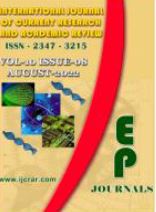Abstract Volume:10 Issue-8 Year-2022 Original Research Articles
 |
Online ISSN : 2347 - 3215 Issues : 12 per year Publisher : Excellent Publishers Email : editorijcret@gmail.com |
2Plan International Ethiopia Oromia Programme Area, Ethiopia
Mango is one of the tree crops cultivated in Ethiopia particularly in the southwestern part of the country; it is the primary fruit crop. A survey was made in Guto Gida and Diga districts of East Wollega Zone during 2016 cropping season to assess the current status, effect, and implication of white mango scale infestation on the target beneficiaries and mango value chain project implementation in the two districts. The discussants in Guttu Gida district disclosed that they observed the infestation of their mango trees for the first time in 2008 and those in Diga observed it in 2010. They also said that they had never ever seen such kind of problem in their mango farm and considered it as a new phenomenon for the people in both districts. For this reason, they did know whether the problem was caused by pest or disease. They commonly called it "Cholera" because of its transmission ability and deadly disease to mango trees. The participants described the effect of the pest on mango production and productivity, though they observed it in mango orchards since 2010, it did not affect the production level immediately, but through time starting from the year 2012 the pest was causing them a drastic reduction in production and productivity. In the year 2014, there was a total failure in mango production and also the harvested one was no market value because of infestation. The effect of the pest in mango grower farmers was so devastating as the mango sell proceeding was used to cover various household expenses like children schooling, purchase of oxen, fertilizer, seed and etc., were done with income derived from. The income earned from mango is, therefore, constituted some 10 -12 percent of the annual income of the households. A total loss of this amount of income most likely caused a great disruption in annual outgoings of households. The impact of the pest in the household livelihoods will be more prominent due to its cumulative effects through time and causing disruption in the normal functioning integrated household economy which one depended on another. The other impact was due to this pest attack, the growers cut mango tree and substitute by other crops. This would cause deforestation, biodiversity loss, causing soil erosion, depletion of surface and underground water and wildfire in the area at large. From the current survey, whit mango scale has become a stumbling block to realize the objectives of mango value chain project in both districts.
How to cite this article:
Tesfaye Hailu, Solomon Tsegaye and Tadele Wakuma. 2022. White Mango Scale Distribution and Its Impact: A case of Guto Gida and Diga Districts of East Wollega, Ethiopia.Int.J.Curr.Res.Aca.Rev. 10(8): 141-150doi: https://doi.org/10.20546/ijcrar.2022.1008.011



Quick Navigation
- Print Article
- Full Text PDF
- How to Cite this Article
- on Google
- on Google Scholor
- Citation Alert By Google Scholar
